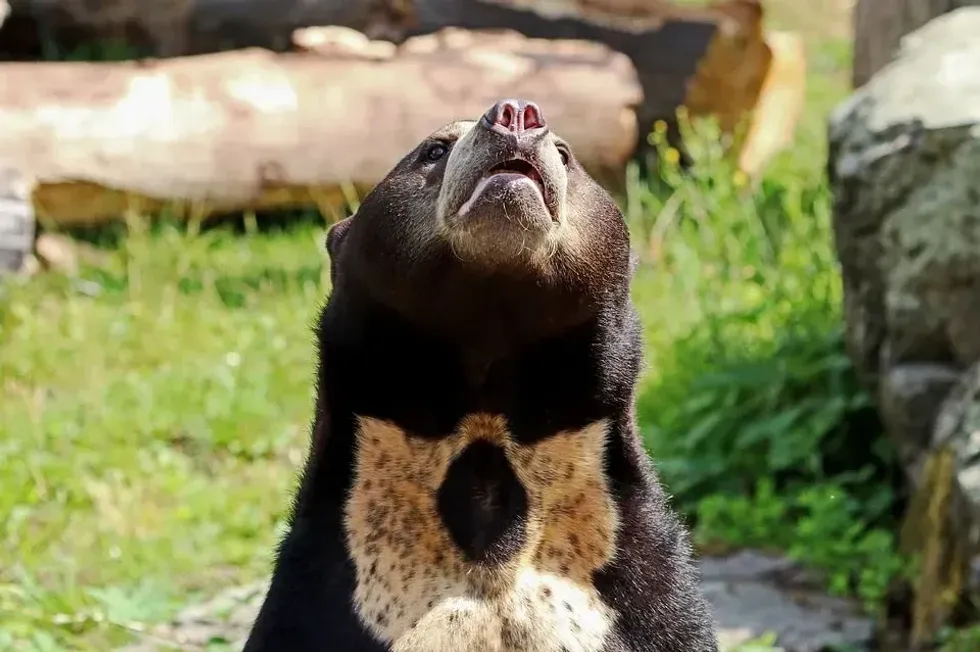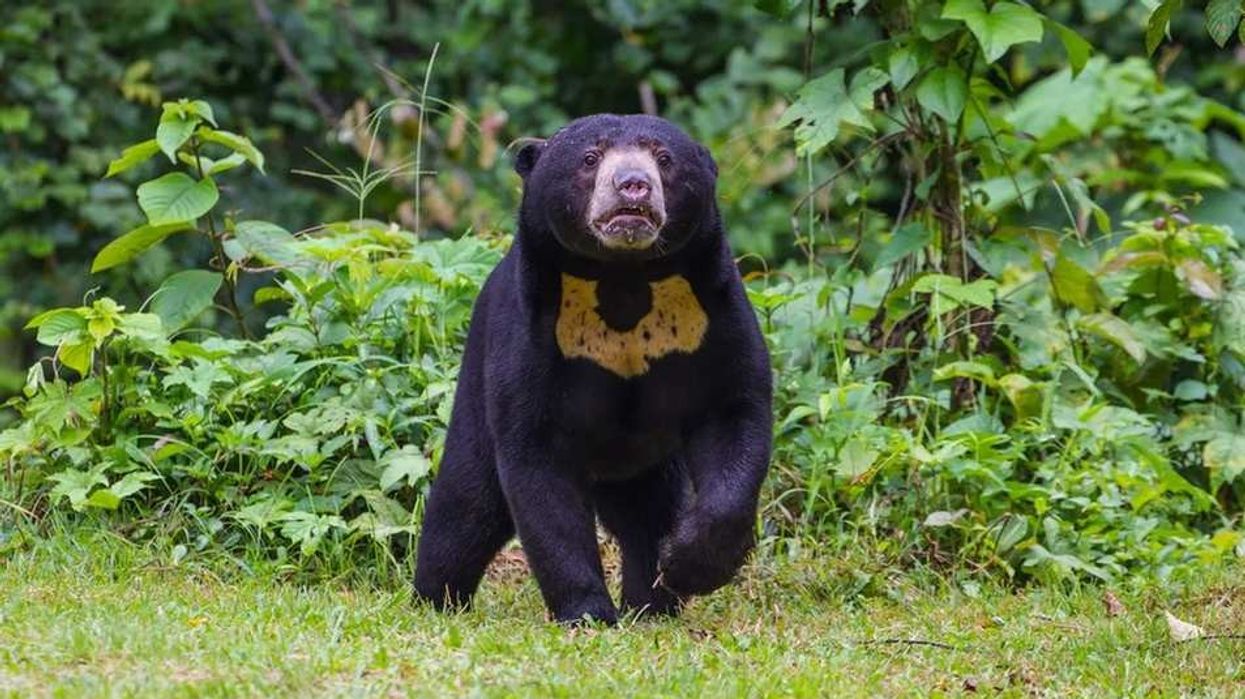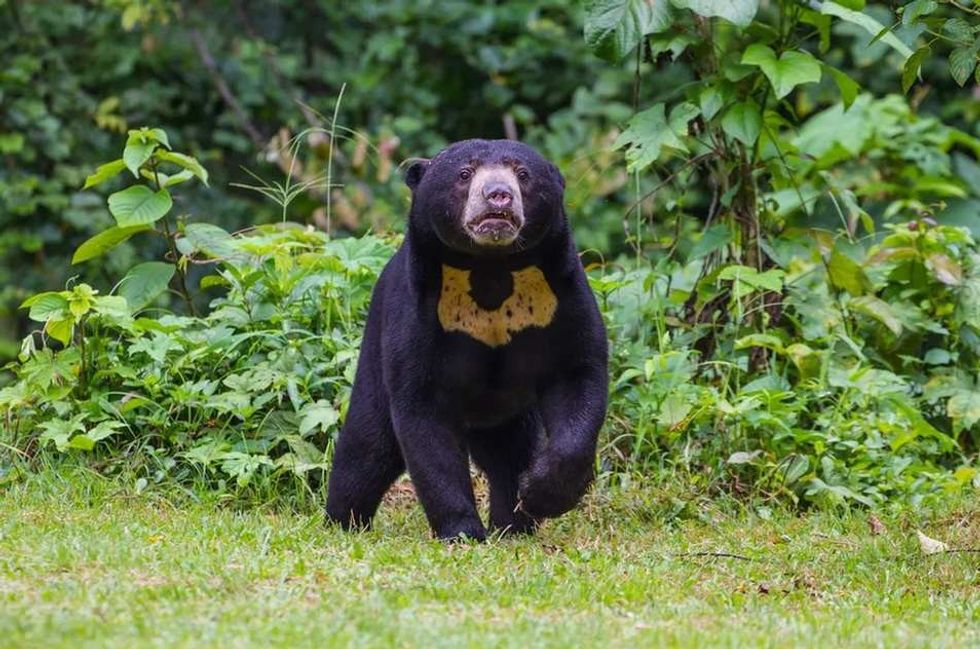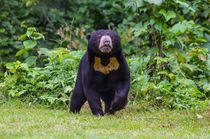Fun Sun Bear Facts For Kids

Content
- What type of animal is a sun bear?
- What class of animal does a sun bear belong to?
- How many sun bears are there in the world?
- Where does a sun bear live?
- What is a sun bear's habitat?
- Who do sun bears live with?
- How long does a Sun Bear live?
- How do they reproduce?
- What is their conservation status?
- What do sun bears look like?
- How cute are they?
- How do they communicate?
- How big is a sun bear?
- How fast can a sun bear move?
- How much does a sun bear weigh?
- What are their male and female names of the species?
- What would you call a baby sun bear?
- What do they eat?
- Are they dangerous?
- Would they make a good pet?
- Did you know...
- Why are sun bears called sun bears?
- Sun Bears vs Moon Bears
Are you a lover of animals and are excited to know more about sun bears? If so, then have a read of this lovely article.
Honey bear is also another name of these bears, as their diet mainly consists of honey. The size is pretty tiny and is the smallest bear known on the planet.
These bears are also called the Malayan sun bear, as plenty were found in Malaysia.
These animals are listed as Vulnerable in the IUCN's Red List, which means that their numbers are decreasing or on the decline with every passing day. If you want to know more about this special type of wild beast, then continue reading this article in facts about sun bears which you are sure to find interesting.
If you like our content on Sun Bears and want to learn about more animals, check out proboscis monkey and ring-tailed lemur facts.
Sun Bear Interesting Facts
What type of animal is a sun bear?
Sun bears, like all other bears, belong to the Ursidae family and are a type of bear.
What class of animal does a sun bear belong to?
The sun bear or the honey bear belongs to the family of Mammalia.
How many sun bears are there in the world?
Owing to numerous factors like climate change and habitat loss, the sun bear population has constantly been on the decline. There is no data that accurately states the total number of sun bears that are present on the planet, however, it is estimated that there are roughly 2,500 sun bears left on earth.
They are an Endangered species of animals and thus conservation is needed for this bear species.
Where does a sun bear live?
Sun bears are wild animals and the sun bear habitat is mostly jungles and in the forests. The Malayan sun bear populations usually live in tropical forests and in the lowlands.
These sun bearrs and their cubs are well versed to stay in the dense hot and humid climate. Malayan sun bears are usually found in Southern China, Malaysia, and parts of Southeast Asia.
What is a sun bear's habitat?
The sun bear is the tiniest in size among all the bear species and varieties of bears found on the planet and are wild animals. Owing to their small size they are extremely arboreal, that is they can climb trees very easily.
This makes them perfect for their habitat, which is the forest. The forest also plays a vital role in the survival of these sun bears.
The tropical jungle habitat provides them with food, and shelter as well as protects them from their predators. They can also live happily in swamps as well as tropical evergreen forests.
Who do sun bears live with?
Sun Bears prefer to stay alone and on their own. They are solitary animals, though they can also be found in small groups. These groups of sun bear usually include the mother bear along with her cub or cubs.
How long does a Sun Bear live?
The general lifespan of a sun bear ranges from 15-25 years approximately when they are left out in their favorite habitat, that is the jungle. However, they do survive more than 20 years in captivity.
How do they reproduce?
The sun bear's reproduction is polyoestrous in nature. Polyoestrous means that the mother bear can give birth to little bear babies all throughout the year.
Sexual maturity is reached within a span of around two to four years. The oestrus period in sun bears lasts for approximately five to seven days.
The gestation period for the sun bears ranges from a period of 95-240 days approximately. It is usually the fact that the pregnancy in sun bears takes a bit longer during captivity especially in the zoos as the climate plays a vital role in the fertilization of sun bears.
It assumed that bears are solitary animals and hence they are also monogamous. The mother bear usually builds nests for the baby on trunks of hollow trees.
The baby bear is born deaf and with its eyes closed, as is a common occurrence in most animals. The mothers are extremely aggressive when it comes to protecting their babies.
Mothers often cradle their babies in their arms. The young baby bear cub remains with their mother for two to four years before leaving on their own.
What is their conservation status?
According to the International Union for Conservation of Nature or IUCN, the population of sun bears is labeled as Vulnerable in the IUCN Red List.
The sun bear species is the smallest bear among all the other eight bear species that are present on our planet and their number is constantly on the decrease. The threats to this bear species are predators which involve the likes tigers, giant birds of prey, and also snakes.
However, the major threat that these sun bears face is that of human activities.
The changes in climate, deforestation, habitat loss, poaching, and habitat destruction have led to the fast and alarming decrease of the sun bears. According to a rough estimate, a mere 2,500 individuals of this species is now all that remains on our planet.
If proper protective measures are not taken, then the animal is going to become extinct at a very fast rate.
Sun Bear Fun Facts
What do sun bears look like?
Helarctos malayanus or the sun bear is the smallest species of bear which is found on earth.
The sun bear is dark black and grayish-black in color and is characterized by a horseshoe that is golden or orange color and is found in the chest of the bear.
The body of the bear is entirely covered in dense black fur which also serves as a protective covering from the harsh forest climates, be it hot or cold, as well as from stings and bites of numerous insects.
Sun bears also have a very long tongue and sharp claws that help them in the tree.

How cute are they?
The sun bear is considered cute by a wide number of people. Owing to its small size when compared to a fully grown adult polar or grizzly bear, the sun bear is usually puny and thus that gives a sudden cuteness to their appearance.
These sun bears have small ears and are muscular and have a short muzzle and a stocky build. All these features together combine to make the sun bears really cute and adorable.
How do they communicate?
The communication of sun bears is pretty interesting. Trees in the forests often have big claw marks which serve as a message for others that a particular bear has already marked the territory.
Apart from marking territories, sun bears also leave their scent on trees and their branches which also serves as a major mode of communication with other bears.
However, the little sun bears, along with these normal means, also have another special mode of communication. Sun bears love copying the facial expression of another and that too is a vital way of communication among bears.
How big is a sun bear?
The sun bear is the smallest among all bears that are present on the plant. Out of the eight species, the Helarctos malayanus is not only the smallest but also the lightest among the lot.
A sun bear standing in front of an average-sized human being looks smaller as they measure around 60 in (152 cm) when it comes to their height.
An average-sized bear measures around 47-94.5 in (1.2-2.4 m). Therefore, we can see that in a sun bear size comparison to a normal average-sized bear, a sun bear is fairly small in size.
How fast can a sun bear move?
On average, a normal-sized bear travels very fast. They can easily acquire speeds of 35 mph (56.3 kph).
The reason for such fast speed is mainly due to the extremely powerful hind legs of a bear.
They can generate huge thrusts and force and thereby gaining momentum in the process. As for direction changing and acceleration, a bear uses its forelegs and thereby also maintains the balance of such a huge body.
In the case of sun bears, there is a scarcity of data and statistics by which we can accurately tell the speed of a sun bear, hence it is unknown.
However, going by the body structure, physical attributes, and the small size of a sun bear, we can easily deduce that Sun Bears are extremely fast and agile creatures and that is also proved by the fact they are arboreal animals and can climb trees quickly. Hence, we can assume that a sun bear's speed is pretty fast.
How much does a sun bear weigh?
Sun bears are the smallest in terms of weight and sizes in comparison with the other species of bears that are present on earth. The average weight of a sun bear ranges from 55-143 lb (25-65 kg).
For an average-sized bear, the weight lies in a range of 154-992 lb (70-450 kg). So we can easily see that weight of the sun bear is almost half the weight in comparison to a fully grown average-sized bear.
What are their male and female names of the species?
In the case of bears, both the animals are labeled with distinct names for males and females. A male bear is called a boar, while a female bear is termed a sow.
What would you call a baby sun bear?
Like all other different bears, a baby bear is called a cub. In the case of a baby sun bear, the correct way to name it would be to call it a sun bear cub.
What do they eat?
Bears are omnivores, and the sun bear is no exception to that. Omnivores are animals that consume both plants and animals.
The diet of a sun bear involves a lot of food products. These food items are either hunted by the bear or are obtained from the jungle or in the place where they live.
As we all know that honey is the most favorite food of bears, and there is no exception with sun bear. A sun bear is extremely fond of honey and it also comprises a major portion of its diet.
Apart from honey, the Sun Bear is also a predator and hunts small invertebrates, insects, termites, bees, and other insects. They also hunt small vertebrates like deer, small reptiles, and birds.
The Malayan Sun bear also feeds on plants like fruits and seeds as part of its diet and plays an active role in the process of seed dispersal in the entire forest. Their long tongue and sharp claws help them in getting this food from inside the trees.
Are they dangerous?
Yes. Bears in general are wild animals, and they are dangerous. However, the sun bear is extremely dangerous.
They are extremely aggressive animals and are often known to attack other animals without prior warning or without any proper cause or reason. The best way is to stay away from the path of a sun bear.
These animals have strong teeth and equally powerful jaws and very strong legs and can be thus referred to as one of the most dangerous animals that you can ever encounter in the forest.
Would they make a good pet?
No. Though bears can be tamed and become less aggressive when they are kept in captivity at the zoo, however, it is advised not to keep a sun bear as a pet.
First of all, since sun bears are wild and exotic animals, there are many laws that can prevent you from keeping one as a pet. Secondly, the sun bear is listed as Vulnerable in the IUCN's Red List and so no one should keep a Sun Bear as a pet.
Did you know...
Though there are many types of bears in the world, the sun bear comes in two different species.
Unlike other bears that hibernate, a sun bear doesn't hibernate, as food is available to them all throughout the year in the tropical forest. Hibernation is a process by which animals go to sleep during the cold months of winter when there is a scarcity of food and water in the wild.
Though the usual lifespan of the sun bear lies in the range of 15-25 years, the highest surviving sun bear lived for 31 years.
The sun bear tongue is extremely thin and long and that comes in very handy when they use it to extract honey from the combs and hives of bees.
Why are sun bears called sun bears?
The reason for naming these bears as sun bears is really interesting. Since these bears have a bib or patch marked in yellow or orange on their chest, it is said to represent that of the rising sun. Therefore, these bears have been named the sun bear.
Sun Bears vs Moon Bears
There is often a debate about the sun bear vs moon bear, so let's settle it.
The moon bear or the Ursus thibetanus is an average-sized bear which like the Sun Bear is an arboreal animal.
The sun bear has the marking of the sun on its chest in the particular colors of yellow or orange while the moon bear has a white and V-shaped patch on its chest.
Like the sun bear, the moon bear is also listed as Vulnerable in IUCN's Red List and these moon bears are usually found in the tropical regions of southeast Asia, including countries like Bangladesh and China.
Many people usually get confused about identifying a sun or a moon bear from one another and this is due to the primary reason that both the species of animals are almost identical in shapes, sizes, and traits.
The only demarcation which can identify and separate them from each other is the marking of the sun and moon on their respective chests.
Here at Kidadl, we have carefully created lots of interesting family-friendly animal facts for everyone to discover! Learn more about some other mammals including Malayan tiger, or North American black bear.
You can even occupy yourself at home by drawing one on our Sun Bear coloring pages.
We Want Your Photos!
More for You
Sources
https://en.wikipedia.org/wiki/Sun_bear
https://www.nationalgeographic.com/animals/mammals/facts/sun-bear
https://animals.sandiegozoo.org/animals/sun-bear
https://wwf.panda.org/discover/our_focus/wildlife_practice/profiles/mammals/sun_bear/
https://a-z-animals.com/animals/sun-bear/
https://www.iucnredlist.org/species/9760/123798233
See All
Bachelor of Arts specializing in Journalism and Mass Communication, Postgraduate Diploma in Sports Management

Moumita DuttaBachelor of Arts specializing in Journalism and Mass Communication, Postgraduate Diploma in Sports Management
A content writer and editor with a passion for sports, Moumita has honed her skills in producing compelling match reports and stories about sporting heroes. She holds a degree in Journalism and Mass Communication from the Indian Institute of Social Welfare and Business Management, Calcutta University, alongside a postgraduate diploma in Sports Management.
Bachelor of Arts specializing in English Literature

Deeti GuptaBachelor of Arts specializing in English Literature
A detail-oriented fact-checker with a research-oriented approach. Devika has a passion for creative writing, she has been published on multiple digital publishing platforms and editorials before joining the Kidadl team. Currently pursuing a Bachelor of Arts in English Literature from St.Xavier's College, Deeti has won several accolades and writing competitions throughout her academic career.
Disclaimer
1) Kidadl is independent and to make our service free to you the reader we are supported by advertising. We hope you love our recommendations for products and services! What we suggest is selected independently by the Kidadl team. If you purchase using the Buy Now button we may earn a small commission. This does not influence our choices. Prices are correct and items are available at the time the article was published but we cannot guarantee that on the time of reading. Please note that Kidadl is a participant in the Amazon Services LLC Associates Program, an affiliate advertising program designed to provide a means for sites to earn advertising fees by advertising and linking to Amazon. We also link to other websites, but are not responsible for their content.
2) At Kidadl, we strive to recommend the very best activities and events. We will always aim to give you accurate information at the date of publication - however, information does change, so it’s important you do your own research, double-check and make the decision that is right for your family. We recognise that not all activities and ideas are appropriate for all children and families or in all circumstances. Our recommended activities are based on age but these are a guide. We recommend that these ideas are used as inspiration, that ideas are undertaken with appropriate adult supervision, and that each adult uses their own discretion and knowledge of their children to consider the safety and suitability. Kidadl cannot accept liability for the execution of these ideas, and parental supervision is advised at all times, as safety is paramount. Anyone using the information provided by Kidadl does so at their own risk and we can not accept liability if things go wrong.
3) Because we are an educational resource, we have quotes and facts about a range of historical and modern figures. We do not endorse the actions of or rhetoric of all the people included in these collections, but we think they are important for growing minds to learn about under the guidance of parents or guardians.







